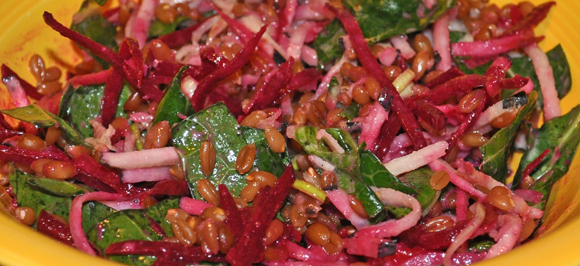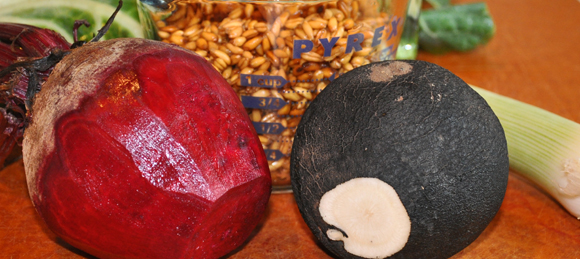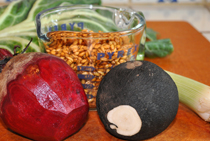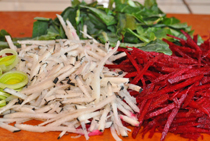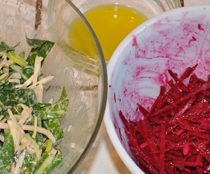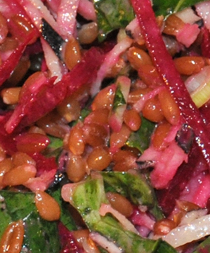October 6, 2022. Here’s this Fall’s perfect all-in-one whole grain and seasonal vegetable salad. Quick and easy to prepare and serve. Everybody ends up amazed how much they love this. Sure, they know this is exactly the kind of dish you should have more of in your diet. But they’re amazed that this unusual salad-like thing is so tasty and satisfying.
You might be amazed, too. It’s cheap and it’s easy. Farmers Markets and CSA farm shares are full of just-pulled beets and radishes and just-picked kale. This is the seasonal replacement for my Summer Lemony farro salad with arugula.
Ingredients
1 large red beet, peeled and julienned
1 large black radish, julienned
1/4-cup of thinly sliced leeks
1 – 2 cups of kale leaves, de-stemmed and sliced
1 cup of farro, uncooked
3 tablespoons of Dijon-style mustard
3 tablespoons of fresh lemon juice
1 tablespoon of grape seed or other neutral oil
2 tablespoons of olive oil
salt to taste
The Whole-Grain Farro
Farro wants to be soaked for at least six hours; eight or ten is OK. So let it soak overnight or all day. Put one cup of farro grains in a small bowl; pour two cups of boiling water on it. Let it be.
When it’s time to cook, drain the farro. Bring four cups of water to a boil, add the farro and a teaspoon of salt, bring it back to a boil, then turn the heat to a gentle simmer and let it go for 25 minutes. When it’s done, rinse and drain.
The Fall Vegetables
While you’re boiling water and simmering farro, prepare the vegetables. No cooking. Just cleaning, peeling, slicing and tearing.
Peel the beet, but leave the soft black skin on that big black radish. Then julienne these root vegetables. They’re crunchy; you’ll want them to be matchstick size. I got it done in less than 3 minutes with my mandoline slicer. For me and my knife, this would take close to 10 minutes.
Then slice the leek and de-stem the kale. I used the Beira kale, also called Portuguese kale, that came with my farm share. It’s soft, not tough, but it’s still a much more substantial green than lettuce. Slice the leafy parts into easily bite-size strips. Slice the leek very thin.
The Salad
While the farro simmers, you still have time to whisk up a batch of that intensely flavorful, near-zero-calorie Mustard-Lemon Dressing. Shouldn’t take you more than three minutes. Now, dress and thoroughly toss the prepared vegetables. If you want the bright white interior of the radish to stay white, dress and toss the beets in a separate bowl and combine them with the farro and other vegetables at the last minute.
When it’s ready, toss your cooked farro with the olive oil and salt to taste. Then add the Fall vegetables and toss some more.
That’s it. So why’s it so good? The light, bright mustard-lemon dressing is great with the earthy, sweet beets and the crisp, sharp radish. And it rubs off very well on the nutty and rich whole grain. And that’s all made even better by the mildly pungent leeks and the cabbage-like sweetness of this kale.
Two of you will clean the salad bowl if this is a main course. Four side servings will disappear a lot quicker than you’d think. So take small bites and eat Slowly.
Substitutes allowed: Any fairly sharp radish will do. If you like yours really sharp, you could use horse radish. If you’re in the mild camp but still want the seasonal crunch, try celery root. And you can always use onion or scallion in place of the leek. Any variety of kale or collard, or spinach, will work well as your green.
Let’s Do The Math
This makes four salad servings. About $1 per salad. Loads of Vitamins A and C. 150 calories you can walk off – briskly – in 30 minutes.
A little Farro history
It’s an ancient grain. Its small version, farro piccolo was the first cultivated grain. We humans have been growing this stuff for more than 10,000 years, but not much lately.
What’s really interesting about the heirloom varieties being grown here and in Italy is the protein content. It’s incredibly high – a close second to the more widely known “super grain”, quinoa.
What’s really attractive about farro is its flavor and texture. It’s nicely nutty – and it’s substantial, really toothsome. It’s resilient and slightly chewy – in a totally good way.
Where to buy farro
I buy it online from Anson Mills, the South Carolina grower-miller that’s the source of my Psychedelic Polenta. Theirs is a “new crop” grain: freshly milled, then slow-roasted. You can buy dried farro at specialty foods stores. I’ve used and liked farro from Rustichella d’Abruzzo, a terrific Italian pasta source. No, it’s not quite as flavorful and firm – but it’s very, very good.
Every Thing Is Everything
Take small bites, chew slowly. You’ll eat less. “Greater oral sensory exposure to a product, by eating with small bite sizes … and increasing OPT [oral processing time], significantly decreases food intake” (American Journal of Clinical Nutrition)
